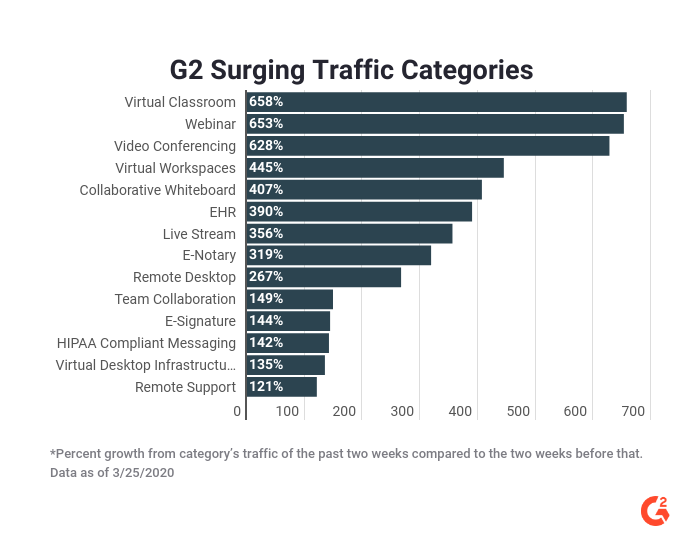By Kara Kennedy, G2 Director of Market Research
88% of businesses have shifted to remote work due to the COVID-19 pandemic, leading us all into uncharted territory.
G2’s research team wanted to better understand how the pandemic is impacting software spend and usage, so we conducted a survey to find out. We found that as customers grapple with how to support their teams and keep the lights on, they’re turning to new software tools to maintain their competitive edge.

In addition, we’ve recently seen massive spikes in traffic around many of the types of software that support distributed workforces. The main increases surround tools that facilitate collaboration, communication, process, and productivity.

This data shows us the shift to remote work does not result in an end to SaaS spending. It simply means SaaS sellers need to adapt to selling remotely. While some reps are used to selling over the phone or via video conferencing from the comfort of their company headquarters, the new twist in this time is that everyone you are selling to is also remote.
Don’t be thrown off by this change. Embrace it. There was a time where sales reps had to wrestle with the idea of forgoing the face-to-face meeting and instead conduct business via email or phone. But it became the new norm and business is better for it. The sales process is constantly evolving. It always has, and always will. What we are living through right now is just another point on the timeline of sales evolution.
With resources thin and demands high, it can feel daunting to consider pivoting your strategy in ways that may not be applicable later on. Let me reassure you: Remote selling is not a temporary trend. Just as the economic downturn of 2008 led to the cloud-based SaaS boom that became the new norm for digitally modern businesses, remote work will become ingrained in the core of the new “business as usual” following this pandemic.
Our State of Deals 2020 Report with PandaDoc, which was set to launch at SaaStr in March, digs into exclusive data about what buyers expect from sellers. We all know how dramatically the world has shifted since then, but the core principles we uncovered about what buyers want, and how sellers can best help them, ring truer now than ever.
To shift to remote selling is not to throw everything you used to do out the window; it is to focus on the core needs and wants of your buyers as you always (should) have, and at the same time understand that deals today are going to be more dynamic, faster evolving, and potentially more complicated than you’re used to.
In our research, we found certain characteristics that the highest performers demonstrate that help them conquer dynamic deals, such as personalizing documents, building trust with prospects, and turning deals around quickly.

Technology-driven processes and dynamic tools are the underlying foundation that allows these high performers to keep up with the rapid evolution of a deal that’s even further exacerbated in a remote environment. These elite sales teams, or teams that implement elite behaviors, are the ones equipped to best adapt to the needs of their customers during the current situation we’re facing, and the “new normal” beyond.

